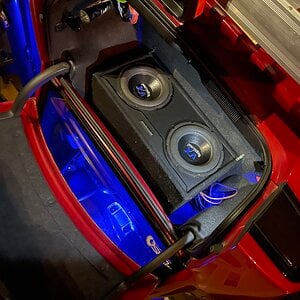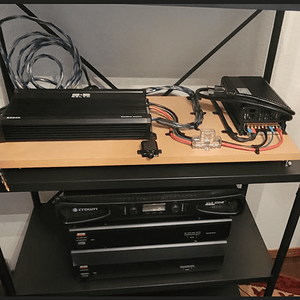Originally posted by Plater Hey buddy if read what i am saying you would fine that it is all factual.
you can't send 20amps to a speaker at 5 volts DC
The impedance of a speaker in usally higher in then the dc resistance but not by much
if a speaker is 4 ohms then a typically dc resistance is 3.6ohms if i put 5 volts across the terminals i will get current flow proportional to the resistance 5/3.6=1.36amps.
The coil satuartes and the speaker pushs in or out depeneding on the polarity
Anyways i am done arguing with you about this you seem to know everything ( jlaine).
I cannot provide 20A to a speaker at 5vdc? Why not?
I was assuming a ridiculously small DCR, because that is what I need to get your current figures. And stay within the performance envelope I was given.
200watt amp,
providing 20 amps of current (10 per channel), that is what I read. Did I read wrong? I may have, but I thought this was the discussion given was it not?
Where did I miss anything? The rest was nothing more than reiteration to prove a point, your 20 amps of current is incorrect. I never mentioned the speaker DCR, as to even get close to 20 amps we need to use a ridiculously small impedance with a high wattage amplifier.
Now, expanding on your own usage of ohms law... (we are using your 200 watt amp here)
DCR = 3.6 ohms.
Amperage = 10A
E = I*R right?
E = 10 * 3.6
E = 36V
See a problem with this? I do... It will take
thirty-six volts!! to pass 10 amps of current through that coil!
Take that, and use P = V^2/R and see what the formula gives you for wattage....
P = 36^2/3.6 =
360 watts! And this is only for ONE SIDE add them both up, to get 720 watts...
Now, via ohms law, the current in the coil of the speaker is the amplifier output voltage, divided by the resistance of said coil at whatever frequency we are dealing with. Note how we calculate current is to base it upon the voltage.
60V/4 ohm coil. (we'll skip the impedance at the exact frequency for now, just because)
15A
P = V^2/R
P = 60^2/4
P = 900W
Just for 15 amps! Just for a single channel! I'd need a 1800Wrms amp to even touch 30 amps of current through a 4 ohm load. Drop the load, and assume current goes up, but what happens when the output fet's cannot keep up with the current demand?
A few things we haven't added to the fray, that need to be.
Inductance
Impedance @ frequency
Your 200W amp? Could do 20A of current...
If it could produce 80V into a 4 ohm load... Makes it much larger than 200W
If it could produce 40V into a 2 ohm load... Makes it much larger than 200W
If it could produce 20V into a 1 ohm load... Makes it much larger than 200W
lets assume it can do a 1 ohm load (easiest to work with here)
P = V^2/R
P = 20^2/1
P = 400
A pure 400W rms, 1 ohm stable amplifier. Double what you suggested, at a quarter of the resistance we were initially dealing with.
You still didn't answer my question... Where do you live? I've never heard of a 110A service..
Settle down plater, I'm not after you, just don't agree completely with what was stated.


